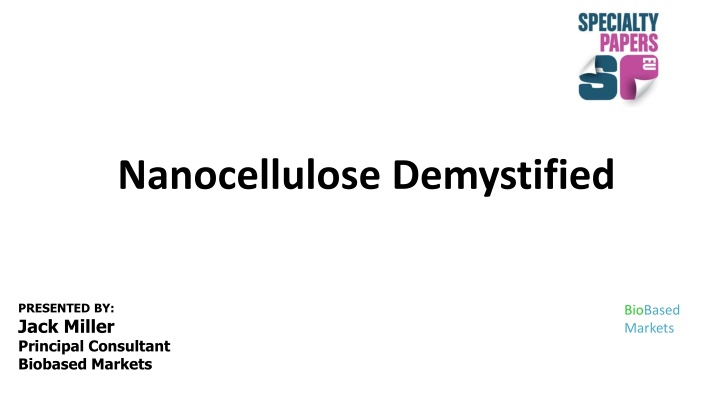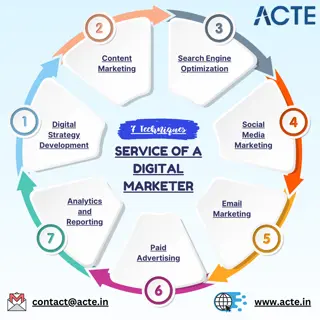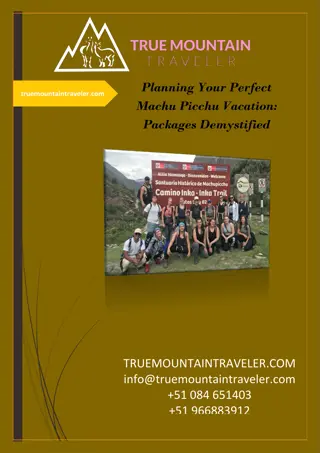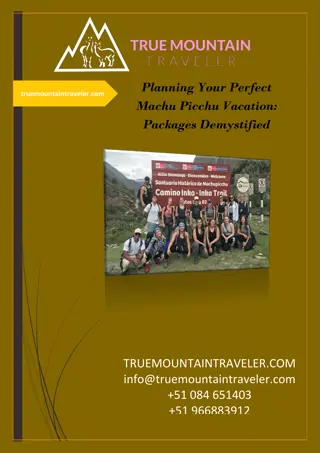
Nanocellulose Demystified: Understand the Technology and Applications
Dive into the world of nanocellulose with insights on its properties, applications, and commercialization journey. Explore why nanocellulose is gaining traction, its unique features, and regulatory standards defining nanomaterials. Discover the potential of nanocellulose in specialty paper, packaging, and beyond.
Uploaded on | 0 Views
Download Presentation

Please find below an Image/Link to download the presentation.
The content on the website is provided AS IS for your information and personal use only. It may not be sold, licensed, or shared on other websites without obtaining consent from the author. If you encounter any issues during the download, it is possible that the publisher has removed the file from their server.
You are allowed to download the files provided on this website for personal or commercial use, subject to the condition that they are used lawfully. All files are the property of their respective owners.
The content on the website is provided AS IS for your information and personal use only. It may not be sold, licensed, or shared on other websites without obtaining consent from the author.
E N D
Presentation Transcript
Nanocellulose Demystified PRESENTED BY: Jack Miller Principal Consultant Biobased Markets BioBased Markets
Acknowledgments Nanocellulose: Producers, Products, and Applications a guide for end users, TAPPI 2017 Nanocellulose: Challenges and Opportunities end user perspectives, TAPPI, 2018 Nanocellulose: Packaging Applications and Markets, RISI, 2019 BioBased Markets
Agenda Why nanocellulose? What is nanocellulose? The road to commercialization Opportunities in specialty paper and packaging BioBased Markets
Why nanocellulose? Very strong Light weight Large surface area Defect-free Chemically reactive Electrically charged Unique optical, electrical, and magnetic properties Renewable Non-toxic Biodegradable Relatively inexpensive BioBased Markets
What is nanocellulose? Is it nano? Is it cellulose? BioBased Markets
What is nano? Very, very small: 10-9 meters Virus: 50 nm Wavelength of light: 400 nm to 700 nm Bacteria: 5,000 nm Human hair: 100,000 nm BioBased Markets
1 - 100 nm in at least one dimension But What percent of the material has to be nano before you can consider it nano ? At what percent nano MUST you consider it nano? What if it is agglomerated? BioBased Markets
What is nano? In the U.S. the EPA Nano rule requires one-time reporting and recordkeeping when manufacturing, importing, or processing nanoscale substances. A reportable chemical substance is: (1) solid at 25 C and standard atmospheric pressure; (2) has particles, aggregates, or agglomerates in the size range of 1 100 nm in at least one dimension (present at concentrations above 1% by weight); and (3) is manufactured to have unique and novel properties as a function of its size (meaning it has different properties than conventional material). In the EU, the Biocidal Products Regulation defines a nanomaterial as a natural or manufactured active substance or non-active substance containing particles in an unbound state or as an aggregate or as an agglomerate and where, for 50% or more of the particles in the number size distribution, one or more external dimensions is in the size range of 1 100 nm. Furthermore, the EU-recommended definition of a nanomaterial also states that when warranted by EHS concerns, the size distribution threshold of 50% or more may be replaced by a threshold between 1% and 50%. Source: J Miller, Nanocellulose Producers, Products, and Applications: A Guide for End Users, TAPPI press, 2017; U.S. EPA Toxic Substances Control Act (TSCA) [FRN 2017-00052], https://www.gpo.gov/fdsys/search/pagedetails.action?granuleId=2017-00052&packageId=FR-2017-01-12; Hansen, S.F., Review and Discussion of Recent Regulatory Developments in Europe When it Comes to Nanomaterials, NanoWorld Conference, Boston, April, 2017; https://www.gpo.gov/fdsys/pkg/FR-2017-01-12/html/2017-00052.htm
What is cellulose? Source: Nanocellulose: Packaging Applications and Markets, RISI, 2019 BioBased Markets
What is cellulose? BioBased Markets Source: CelluForce
What is nanocellulose? crystalline region: amorphous region BioBased Markets
Types of nano cellulose Cellulose nanofibrils (CNF) Cellulose nanocrystals (CNC) Microfibrillated cellulose (MFC) Cellulose filaments (CF) Different forms of CNC Different forms of CNF Different forms of MFC And MCC, CMC, etc. BioBased Markets
What is CNC? Cellulose nanocrystals, also called nanocrystalline cellulose (NCC) or cellulose nanowhiskers Less than 100 nm in at least one dimension: e.g., 5 nm x 100 nm Typically produced by acid hydrolysis Can have surface charge and chiral nematic properties Discrete nanoparticles with high crystallinity Good for strength, reinforcement, rheology, optical, electrical, chemical properties BioBased Markets
What is CNF? Cellulose nanofibrils, also called nanofibrillated cellulose (NFC) Less than 100 nm in at least one dimension: e.g., 5-20 nm x 500 3,000 nm Produced primarily by mechanical means, sometimes with enzymatic or chemical pre-treatment Not discrete particles: nano-sized bundle of fibrils Good for strength, reinforcement, rheology BioBased Markets
What is MFC? Microfibrillated cellulose (MFC) Likely not less than 100 nm in at least one dimension Often produced at mill for use on-site in papermaking Produced primarily by mechanical means Not discrete particles: micro-sized bundle of fibrils Good for strength, reinforcement, rheology BioBased Markets
CNF and MFC Characteristics (particle diameter in nanometers) BioBased Markets Source: J. Miller, Nanocellulose Producers, Products, and Applications:A Guide for End Users, TAPPI, 2017
Characteristics of nanocellulose Compatibilization Dispersibility Crystallinity Degree of fibrillation Charge Chemistry Purity Particle size Aspect ratio Powder, paste, slurry, gel Is it cellulose? Is it nano, micro, macro? BioBased Markets
Characteristics of nanocellulose Compatibilization Dispersibility Crystallinity Degree of fibrillation Charge Chemistry Purity Particle size Aspect ratio Powder, paste, slurry, gel Is it cellulose? Is it nano, micro, macro?
BioBased Markets
The road to commercialization YOU ARE HERE BioBased Markets Source: GAO
Commercial challenges Proof of concept Need solid value proposition through the supply chain Competitive materials Low oil prices Funding challenges: the Valley of Death Market development Applications development Who develops the applications? Who does the R&D? Who owns the IP? Which material is best for a given application? What loading is optimal? It is not a drop in : implications for customer process Scale up in production Scale up of applications Consistent quality from batch to batch Lack of multiple sources of supply Safety and regulatory issues
Cost alone does not define the business case $60 $50 Breakeven nano cost $40 $30 loading 0.3% $20 1.0% $10 5.0% $0 2% 4% 6% 8% 10% 12% 14% 16% Weight reduction BioBased Markets Source: Biobased Markets
Opportunities for nanocellulose in packaging and specialty papers Obviously BioBased Markets
Opportunities for nanocellulose in packaging and specialty papers Obviously, strength BioBased Markets
Opportunities for nanocellulose in packaging and specialty papers Obviously, strength and barrier BioBased Markets
Enhanced strength and barrier enable lightweighting lightweighting to reduce environmental impact lightweighting to reduce material cost lightweighting to reduce transport cost BioBased Markets
Enhanced strength and barrier enable lightweighting lightweighting to reduce environmental impact lightweighting to reduce material cost lightweighting to reduce transport cost But it s not just about light weighting But it s not just about light weighting BioBased Markets
Applications development with paper and paperboard Base sheet additives Strength: tear, tensile, Scott bond Wet web strength: runnability Porosity Opacity Reduce fiber cost Surface applications Holdout/porosity Printability Barrier Smoothness Opacity Reduce cost BioBased Markets Source: Nanocellulose: Packaging Applications and Markets, RISI, 2019
Specialty and Packaging Opportunities wet-end web strength permits greater productivity lower cost fiber: recycled vs. virgin; hardwood vs softwood more low-cost filler; less fiber more filler means more opacity and better printability coatings to eliminate harmful materials such as fluorocarbons improved barrier to replace plastic, glass, or metal eliminate non-recyclable films and foils biodegradable materials to replace non-biodegradable materials BioBased Markets
Key takeways There are several different types of nanocellulose Many opportunities especially in specialty paper and packaging Applications development is needed BioBased Markets
Thank you Thank you Nanocellulose: Producers, Products, and Applications a guide for end users, TAPPI 2017 Nanocellulose: Challenges and Opportunities end user perspectives, TAPPI, 2018 Nanocellulose: Packaging Applications and Markets, RISI, 2019 PRESENTED BY Jack Miller Principal Consultant Biobased Markets jackmiller@biobasedmarkets.com BioBased Markets


















